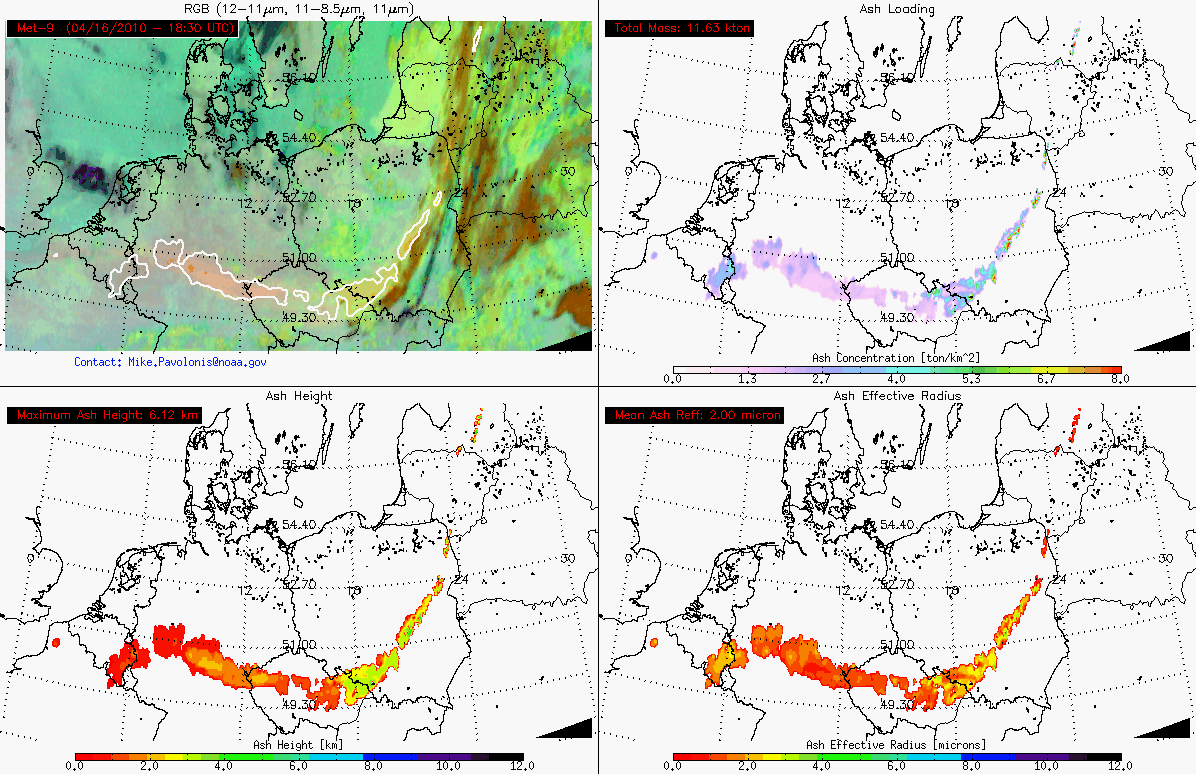
[ Archive ]

 |
ASPB and CIMSS Weekly Report
[ Archive ] |
 |
IN THE PRESS:
WGN TV report includes CIMSS : WGN TV
(Chicago, IL) aired a 6 minute program on April 12, 2010 on improvements
in observations, models and technology that forecast, identify and
track severe weather events. The program included imagery and products,
and scientist interviews from NOAA facilities and from the Cooperative
Institute for Meteorological Satellite Studies (CIMSS). WGN TV plans to
show additional material from their CIMSS visit in future programming on this
topic. The video can be found at
http://www.wgntv.com/videobeta/eb0006ff-06bd-40ef-9a84-d23d88b4b513/News/Tom-Skilling-Fermilab-A-Revolution-in-Forecasting.
(T. Achtor, CIMSS, 608-263-4206, S. Ackerman, CIMSS, 608-263-3647, T.
Schmit, E/RA2, 608-263-0291, tim.j.schmit@noaa.gov)
ITEMS FOR THE ADMINISTRATOR:
ITEMS FOR THE ASSISTANT ADMINISTRATOR:
ITEMS FOR THE OFFICE DIRECTOR, STAR:
Satellite Monitoring of Eyjafjallajokull Volcanic Ash: The
Eyjafjallajokull volcano, located on Iceland, erupted several times
during the week of April 11, 2010. The resulting ash clouds have
severely impacted trans-Atlantic aviation, causing more than 4000
flights to be cancelled. The next generation Geostationary Operational
Environmental Satellite (GOES-R) volcanic ash detection and property
retrieval algorithm was applied to Spinning Enhanced Visible/Infrared
Imager (SEVIRI) imagery of the Eyjafjallajokull ash cloud. The GOES-R
ash algorithm successfully detected the ash cloud and the retrieved ash
cloud heights that compared well to spaceborne lidar. These products provide
critical information on ash cloud height, mass loading, and particle
size. The GOES-R products and additional satellite imagery were posted
to the Cooperative Institute for Meteorological Studies (CIMSS)
Satellite Blog at http://cimss.ssec.wisc.edu/goes/blog/archives/5137.
(M. Pavolonis, E/RA2, 608-263-9597, Mike.Pavolonis@noaa.gov, S.
Lindstrom, CIMSS, S. Bachmeier, CIMSS, J. Sieglaff, CIMSS)
 (Click image to enlarge)
(Click image to enlarge)
Figure caption: Results from the automated next generation Geostationary
Operational Environmental Satellite (GOES-R) volcanic ash detection and
retrieval system are shown for ash clouds produced by eruptions of
Eyjafjallajokull, Iceland on April 15, 2010. A false color image is
shown in the upper left panel, the ash mass loading in the upper right
panel, the ash cloud height in the lower left panel, and the ash cloud
effective particle radius in the lower right panel. The outline of the
ash clouds detected by the automated algorithm is contoured in white on
the false color images. These images show the ash cloud over Germany,
the Czech Republic, and Poland on April 16, 2010 at 18:30 UTC.
Paper Published on MODIS Arctic Cloud Detection and Trend Analysis: A paper titled "Errors in cloud detection over the Arctic using a satellite imager and implications for observing feedback mechanisms" was published in the Journal of Climate (Vol. 23, No. 7, 1894–1907). The authors are Yinghui Liu (Cooperative Institute for Meteorological Satellite Studies, CIMSS), Steven A. Ackerman (CIMSS), Brent C. Maddux (CIMSS), Jeffrey R. Key (NESDIS/STAR), and Richard A. Frey (CIMSS). The article evaluates the Moderate Resolution Imaging Spectroradiometer (MODIS) cloud detection performance with changing surface conditions in the Arctic and identifies its implications for climate studies. (Y. Liu, CIMSS, 608-265-8620)
ITEMS FOR THE DIVISION CHIEF, CoRP:
CIMSS and ASPB Provide Support for the Switch from GOES-12 to GOES-13: At 1834UTC on April 14, 2010, the Geostationary Operational Environmental Satellite (GOES)-12 was replaced with GOES-13 (http://cimss.ssec.wisc.edu/goes/blog/archives/5116) as the U.S. operational eastern geostationary satellite. Cooperative Institute for Meteorological Satellite Studies (CIMSS) and Advanced Satellite Products Branch (ASPB) scientists have been instrumental in supporting GOES-13 from before the GOES-13 Science Test (December 2006, http://journals.ametsoc.org/doi/pdf/10.1175/2008BAMS2564.1) through the just-completed pre-operational transitional phase. For example, a cold bias was found on band 6 of the Imager, and a correction was suggested and implemented. New Planck coefficients were generated and distributed to NOAA/NESDIS operations. Also, after GOES-13 came out of storage mode at the end of January 2010, several cases of the CIMSS Intercalibration method were run and the GOES-13 Imager was determined to be operating as expected in comparisons with the polar-orbiting Infrared Atmospheric Sounding Interferometer (IASI), with similar brightness temperature differences as seen when GOES-13 was last transmitting data before being put into storage mode. At various times throughout the entire process, imagery and products that use GOES-13 Imager and Sounder data have been displayed on the CIMSS GOES Realtime Derived Products web page (http://cimss.ssec.wisc.edu/goes/rt); products include atmospheric profiles, derived product images, cloud information and clear-sky brightness temperatures. (J. P. Nelson III, CIMSS, 608-263-6013; M. Gunshor, CIMSS, 608-263-1146; T. Schmit, E/RA2, 608-263-0291, tim.j.schmit@noaa.gov; T. Schreiner, CIMSS, 608-263-6754; G. S. Wade, E/RA2, 608-263-4743,gary.s.wade@noaa.gov, Scott Bachmeier, CIMSS 608-263-3958)VISITORS:
CM-SAF Visitors: Andrew Heidinger hosted two visitors from the EUropean organization for the exploitation of METeorological SATellites (EUMETSAT) Climate Monitoring Satellite Application Facility (CM-SAF). The visitors (Drs Ronald Scheirer and Jan-Fokke Meirink) came from the Dutch and Swedish Meteorological Agencies. Discussions were held on the on-going efforts to extract long-term cloud climate records from NOAA, NASA and EUMETSAT sensors. Andrew Heidinger will visit these institutes later this summer. (A. Heidinger, E/RA2, 608-263-6757, andrew.heidinger@noaa.gov)
NEXT WEEK:
LOOKING AHEAD:
| Archived Weeklies Page | Submit a report item |